Hibiscus flowers come in a variety of sizes, shapes, and colors. In addition to being the national flower of Malaysia, the Hibiscus is also a native flower of Hawaii. Known as the Queen of the Tropics, it grows wild in many tropical, subtropical, and warm-temperate regions worldwide. Plants from this family have many uses, including ornamental use, fiber production, food production, and medicine. In winter, Hibiscus is best grown in pots at least 10-12″ across and then moved to a warm, bright place. This can be a heated greenhouse or a heated room in a house.

How to Grow Hibiscus in a Greenhouse
Sunlight Requirements for Growing Hibiscus in the Greenhouse
Hibiscus plants love lots of sunlight. The more direct sunlight they receive, the better they will bloom. Aim for 8 hours of direct sunlight per day. If you plant your Hibiscus in the greenhouse, ensure it’s in a spot where tall trees or nearby fences won’t shade as they can sometimes tolerate partial shade, but their blossoms won’t be as impressive or frequent. You can move a container of Hibiscus around to ensure it’s getting enough sunlight, so keep an eye on them to ensure they are thriving in its chosen location.
Soil Requirements for Growing Hibiscus in the Greenhouse
All Hibiscus grow best in a well-drained, fertile, moist, loamy soil. These hardy varieties are native to wetlands and are suitable for wet sites. While most Hibiscus prefer a slightly acidic soil pH, the rose of Sharon is tolerant of alkaline soils. Depending on the soil’s acidity, Hibiscus flowers can have different colors. If your location experiences dry conditions, mulching around the plant base can help retain moisture. It is beneficial to amend nutrient-poor soil with organic matter.
Temperature Requirements for Growing Hibiscus in the Greenhouse
The Hibiscus cannot tolerate cold temperatures. Warm temperatures are necessary for flower buds to develop on the plant. Keep them in greenhouses with daytime temperatures no lower than 13°C in a warm, sunny location. Temperatures between 18 and 24°C are ideal. Too cold may cause flower buds to drop off or fail to form. Neither extreme temperature changes nor extreme humidity changes will harm Hibiscus.
Growing Hibiscus From Cutting
- Hibiscus is most commonly grown from cuttings, which is how most growers and greenhouses produce new plants
- Select the strongest shoots and cut them into 3″-5″ pieces.
- Put the cut ends in a small pot filled with a light potting mix after dipping them in a rooting hormone compound.
- Make sure it is slightly moist and placed in a bright area.
- After 3-5 weeks, they should have developed a good root system and be ready for transplantation.
- When the cutting has rooted, cut or pinch off the top inch of the stem just above a leaf node to encourage a bushier plant.
- The amended planting site should be dug twice as deep and three times as wide as the root ball of the Hibiscus.
- Ensure that the planting hole is prepared carefully before placing the Hibiscus.
- The planting hole should be filled halfway with the soil dug from the hole and then watered to eliminate air pockets and settle the plant.
- Finish filling the hole and patting down the soil around the plant.
- A one-inch layer of earthworm castings should be added around the base of the plant, and then water it again until the soil and castings are well moistened.
In case you missed it: How to Grow Hibiscus from Cuttings: DYI in 10 Simple Steps

Water Requirements for Growing Hibiscus in the Greenhouse
Water with a pH of 5.5 to 6.5 and low dissolved minerals is best for growing them, but they will also grow in water with a pH range of 5.0 to 7.0 and moderate hardness. Hibiscus plants must be thoroughly watered every few days for the first few weeks after planting. During the first growing season, perennial Hibiscus should be watered twice weekly. If it rains several days a row, water once a week during the second growing season and beyond.
Fertilizers Requirements for Growing Hibiscus in the Greenhouse
Hibiscus responds best to fertilizers high in potassium (K), medium in nitrogen (N), and low in phosphorus (P), such as NPK 10-5-20. During the growing season, fertilize every two weeks with a liquid or slow-release fertilizer.
Pruning Hibiscus
During pruning, Hibiscus plants should be cut back about a third, leaving two to three nodes on each branch for new growth. Make these cuts just above the nodes, leaving about a quarter-inch (0.5 cm). Strong, diseased, or dead growth and crossing or leggy branches should be removed. Branches growing toward the plant’s main stem should also be removed. Spring is the best time to prune Hibiscus. In late summer and early fall, Hibiscus plants can be lightly pruned, but in the late fall and winter, they cannot.
Pests and Diseases management
Several pests and diseases can affect Hibiscus. Premature flower dropping and failure to bloom and thrive are symptoms of insect pest damage to Hibiscus. There are holes in leaves and petals and a sticky substance on nearby plants and surfaces. Aphids, spider mites, thrips, and whiteflies are common pests.
Make sure the Hibiscus plant is free of pests and pest damage by inspecting it periodically. Use a strong spray of water to remove pests from minor infestations. Sulfur Dust should be applied for more severe or recurring infestations. Combining insecticides and fungicides, this insecticide kills immediately without harming plants.
There are also diseases associated with Hibiscus leaves, including gray mold (botrytis), downy mildew, and powdery mildew. Symptoms include white, gray, or yellow spots on leaves, leading to moldy buds that fall off before blooming. The plant should be treated with Sulfur Dust if symptoms appear.
Harvesting and Preparing Hibiscus Flowers
The flowers should be cut with a pair of sharp scissors or pruning shears. Use only pesticide-free Hibiscus flowers to avoid contamination. Give the flowers a light wash with water to remove dirt from the petals and remove the stamens (the yellow parts in the middle of the flower).
In case you missed it: How to Grow Roses in Greenhouse: A Step-By-Step Guide from Planting Stem Cuttings to Harvest

Conclusion
A vibrant Hibiscus plant that lights up your garden with blooms is a rewarding experience. Following these planting and maintenance tips, you can enjoy abundant, colorful blooms and healthy, vigorous Hibiscus plants all summer. During cold weather, Hibiscus needs warmth. A greenhouse is necessary for plants in cold climates.
- Feed Your Flock for Less: Top 10 Tips to Save on Chicken Feed
- Ultimate Guide to Ossabaw Island Hog: Breeding, Raising, Diet, and Care
- Hatching Answers: The Top 10 Reasons Your Chickens Aren’t Laying Eggs
- Eggs and Economics: Breaking Down the Cost of Raising Backyard Chickens
- Defend Your Greens: Proven Methods to Keep Iguanas Out of Your Garden
- Ultimate Guide to Cinnamon Queen Chicken: A Comprehensive Guide for Beginners
- Ultimate Guide to California Tan Chicken: Breeding, Raising, Diet, Egg-Production and Care
- Ultimate Guide to Marsh Daisy Chicken: Breeding, Raising, Diet, and Care
- 10 Types of Chicken Farming Businesses You Can Start for Profits